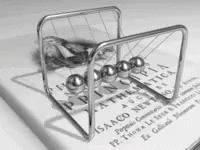1. Fundamental Concepts¶
A common stumbling block when first learning physics is the unfamiliarity with mathematics as a precise language for expressing and manipulating ideas. Using mathematics is a crucial skill that can only be developed with sufficient practice, which presents a chicken-and-egg dilemma to beginners: One needs to speak mathematics fluently to fully understand physics, but also needs to know enough physics to practice the relevant mathematics.
It is easy to miss the bigger picture when struggling with unfamiliar technicalities of the material. Unfortunately, this conflation of physics as a subject with the often steep learning curve of its mathematics makes it difficult to motivate why one would want to put in the required effort to develop the technical skills in the first place. Importantly, however, it is the ideas of physics that are essential for understanding observation, with the mathematics enabling quantitative and predictive realizations of those ideas.
Fundamental ideas play the most essential role in forming a physical theory. Books on physics are full of complicated mathematical formulae. But thought and ideas, not formulae, are the beginning of every physical theory. The ideas must later take the mathematical form of a quantitative theory, to make possible the comparison with experiment.
Albert Einstein, The Evolution of Physics (1938)
The study of physics unlocks a deeper understanding of how the world around us works. The physical intuition gained consequently enables a richer experience and appreciation of the world and our place in it. This shift in perspective is profound and well worth the effort, independently of the technical ability to convert that intuition into quantitative prediction.
This supplement aims to address the cyclic dependency of physics and mathematics by introducing the core physics concepts independently from their mathematical formulations. Similarly, the supplement will systematically review the language of mathematics independently from the core physical concepts, then revisit the core concepts in more depth once the appropriate mathematics has been introduced. The notes are designed to be quickly cross-referenced to help put both the concepts and their mathematical representations in their proper context.
